The fifth anniversary Łódź Design Festival and the third edition of Warsaw Under Construction complemented each other perfectly this year, especially with regard to the premises and methods assumed by the curators. Any juxtaposition of the two events must bear in mind the unique character of both cities and the different audiences to which the festivals were addressed.
A festival for citizens
Warsaw Under Construction aims to activate the inhabitants (or rather the users) of the city. The event’s intended audience includes people who profess a certain consciousness and responsibility, such as members of local communities and city dwellers (old and new) who wish to make better use of the opportunities offered by their surroundings; people who play an active role in shaping the cultural character of a given place and whose needs surpass the minimal and default offerings of every urban centre: sleep, food, work, and leisure.
Using the lack of a permanent headquarters to its advantage, the Museum of Modern Art — the institution behind Warsaw Under Construction — forced its audience to move around and explore new areas of the Polish capital, from such central locations as the Warsaw School of Economics’ Art Deco building, designed by Jan Koszczyc Witkiewicz, in the heart of Mokotów, to suburbs such as Wólka Kosowska (Lesznowola commune), which has become a new hub for Vietnamese tradesmen. Without active participation on the part of the audience, most of the talks, tours, and workshops would be entirely pointless. In short, Warsaw Under Construction is constructed by its inhabitants, even those who are just passing through. With this in mind, one of the festival’s think tanks prepared a “Manifesto on Non-participation” in which the authors attempt to find an explanation for why some choose not to take part in the social and cultural life of a city.
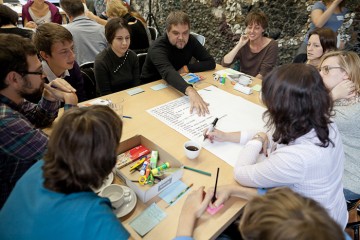 “Let’s start a co-op business!” workshops
“Let’s start a co-op business!” workshops
photo: Bartosz Stawiarski
This year’s edition featured a variety of fields of exploration, all of which involved the use of urban space, particularly spaces that fulfilled the more or less common needs of the city’s inhabitants. Themes included co-ops and the opportunities available to residents of apartment complexes (covered by a three-part workshop titled “Let’s start a co-op business!”, a series of walks around the Żoliborz Orchards, walks around apartment complexes, and a balcony-themed tour of Służew), as well as Warsaw urban development post-1989, the problem of the discoursification of postmodern architectural heritage, and attempts to identify the characteristic elements of “hot-spots” on the map of Warsaw and find appropriate scenarios through which they can be counteracted in the future. The last category addressed issues such as sports and recreational facilities that have either fallen into a state of disrepair or have been reserved for big events taking place during the 2012 Euro Cup, as well as the gentrification of Warsaw’s east bank neighbourhoods — the topic of the festival’s closing debate.
A festival for professionals
The Łódź Design Festival is Poland’s leading event created for professionals in a number of areas associated with the creative industries. Its purpose is to showcase Polish and international achievements in the field of industrial design. The festival’s school shows, competitions, and curated exhibitions are an opportunity for debut designers to display their work, while entrepreneurs and the heads of prestigious international commercial fairs seek out young talent (through contests such as “Make me!”) and share their experience in a series of talks. The general public, meanwhile, is given a chance to admire the objects on display at exhibitions such as NeoFarm, Interior Energy. Scandinavian Style, and the competition shows Must Have and Young Polish Design.
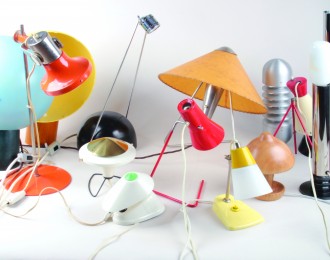 Light Sculptures, Czech lamps, 1950-1990
Light Sculptures, Czech lamps, 1950-1990
Łódź Design Festival 2011
This year marked a special edition of the festival. The organisers of ŁDF decided that the conditions were right for the festival to become a representative event for design from all over East and Central Europe. While Poland’s neighbours do hold similar events, such as Design Week in Prague and Budapest, none last long enough to attract an audience as great as Łódź does. For this reason, the 2011 edition hosted for excellent exhibitions from the Czech Republic, Hungary, Ukraine, and Slovenia at the former Eitington textile factory at ul. Targowa 35, a modernist building erected in 1928–1930 with a beautifully renovated exterior and an almost untouched interior, complete with charming crumbling plasterwork.
The group “Okolo” illustrated the history of Czech design through the changing typology of table lamp designs, from the characteristic Brussels style to the hi-tech designs of the 70s and 80s. Journalist and curator Ksenia Kaniewska held the first Western exhibition of contemporary Ukrainian design, while the Budapest-based medialab “Kitchen Budapest” encouraged the audience to interact with devices that react in real time, such as a sampler programmed to run on four iPhones, or LANdelion, an LED lamp that responds to voice and movement with sounds and changes in brightness, in what was likely the first instance of sound-based design at the Łódź Design Festival. Slovenia, the southernmost country present the festival, was represented by the world-renowned Balkan designer Nika Zupanc
Responsible architecture
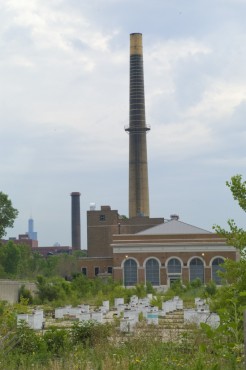 Redirection, Chicago Honey Co-op
Redirection, Chicago Honey Co-op
/ photo Amanda Temple, Łódź Design
Festival 2011
This year’s edition made it apparent that the Łódź Design Festival is searching for a new format and seeking to broaden its scope to include all possible fields of design, not just those associated with the manufacturing of pretty objects, clothes, interiors, and printed material. Incidentally, the exhibition presented this year by the STGU (Association of Applied Graphic Designers), titled Overdesigned? was exceptionally disappointing, not so much due to the content but rather the (intentionally?) chaotic method of display.
Alongside visually attractive arrangements with straightforward messages, two exhibitions stood out in terms of both content and appearance: Design Faction, curated by Kasia Jeżowska, which explored the areas between design and science, and Redirection, held by Warsaw’s Centrum Architektury (Aleksandra Stępnikowska, Agnieszka Rasmus-Zgorzelska, and Jarosław Trybuś). One of the two exhibitions in the main programme, Redirection brought up the most pressing issues in responsible and sustainable contemporary architecture. The curators ventured the opinion that the time of great narratives is long gone and that contemporary architects must face a number of threats and crises such as overpopulation, growing income inequality, environmental catastrophes, and power outages. The extraordinarily interesting exhibition featured innovative case studies from all corners of the world, including an exceptional documentary about Chicago’s amateur beekeepers, whose hobby is helping save an endangered species that plays a crucial role in pollinating plants, thus indirectly producing fruits and vegetables, and which also provides a valuable product to local communities. Also among the displays at Redirection was a vertical vegetable garden planted in large flower pot, a sign of the growing phenomenon of urban gardening and the redefining of the role of food production and culture in cities.
The same theme was explored at Warsaw Under Construction, which hosted an appearance by Richard Reynolds, a pioneer in the field of guerilla gardening. The charismatic Englishman generated great interest among the Warsaw audience, resulting in an extensive Q&A after the talk and likely inspiring many of those present to make their own seedbombs.
The aesthetics of the city
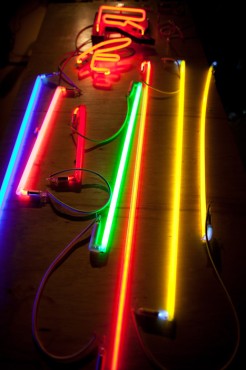 Paulina Ołowska The Life of Neons,
Paulina Ołowska The Life of Neons,
photo: Bartosz Stawiarski Audiences also turned up in great numbers for a Warsaw Under Construction event devoted to the subject of the capital’s neon signs, at which Tomasz Gamdzyk — the advertiser-indoctrinated head of the municipal office tasked with overseeing the aesthetic appearance of public spaces — unwittingly eclipsed a performance by Paulina Ołowska, which introduced audiences to Warsaw’s dark and forgotten neon signs. The artist is known for her renovation of the “Volleyball Player” sign overlooking Plac Konstytucji and her neon logo design for the Museum of Modern Art’s temporary headquarters. The discussion helped illustrate the obstacles involved in working with the municipal government and questioned whether the model for community participation developed at the festival’s workshops, talks, and brainstorming sessions could actually result in better communication between citizens and decision-makers. The case of Tomasz Gamdzyk shows that dialogue has not yet been achieved. The current stage of cooperation is that of conflict, although some claim it is this stage that is the most productive and has the greatest potential for change.
Clearly insensitive to the abstract and intangible value of art in public spaces, or aesthetic education in general, Gamdzyk encouraged citizens to organise associations in the belief that interest groups would be more successful at getting their message across than frustrated individuals stubbornly demanding their rights. He thus made it abundantly clear that he preferred to deal with representatives of large corporations.
Discovering postmodernism
Speaking of aesthetic disappointments, one cannot fail to mention the substantial reevaluation that occurred both at WUC3 and ŁDF, namely the application of the postmodern aesthetic in architecture and product design (furniture, lighting, etc.). This trend, regarded by many as the epitome of kitsch and poor taste, has made a comeback as a sort of ironic inside joke. The Łódź Design Festival featured accents of this type in the exhibition devoted to Ukrainian design, which lacks roots and started from nothing in the 90s, and takes inspiration from such disparate sources as the internet, Western magazines, international classics of design, and nouveau riche solutions born of the rampant capitalism of the 1990s. It seems that what’s missing in Polish industrial design is a certain impulse that would allow for designers to feel comfortable making joking references to this tradition.
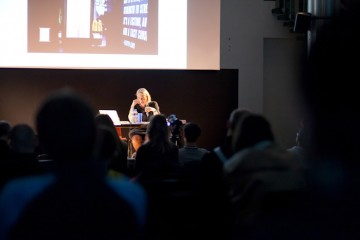 Jane Pavitt speaks at Warsaw Under Construction
Jane Pavitt speaks at Warsaw Under Construction
photo: Bartosz Stawiarski
Warsaw Under Construction did at least include an exhibition and session devoted to the postmodern experience in Polish architecture and its colonial genesis. Among the members of the panel were renowned researcher Jane Pavitt, co-author of the legendary title Cold War Modern: Design 1945–1970 (with David Crowley) and co-curator of a new exhibition at London’s Victoria and Albert Museum, Postmodernism: Style and Subversion 1970–1990. Almost concurrently published in Poland were Walter Benn Michaels’ The Shape of the Signifier: 1967 to the End of History and Bartosz Kuźniar’s Goodbye Mr. Postmodernism.
We will have to wait for a Polish Venturi to provide a local adaptation of the methodology used in the famous Learning from Las Vegas (a sociological analysis of the aesthetic chaos and visual communication observed in big cities and their sprawling suburbs). There are more than enough subjects to study, with Raszyn likely being the best candidate for a case study. I hope next year’s edition of Warsaw Under Construction addresses this fascinating issue.
Warsaw Under Construction 3, Museum of Modern Art in Warsaw. Curated by Sebastian Cichocki and Tomasz Fudala. 1–30 October, 2011. Łódź Design Festival 2011, Łódź Art Center, Łódź. 20–30 October, 2011.
translated by Arthur Barys










